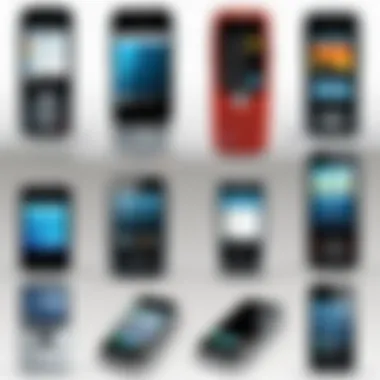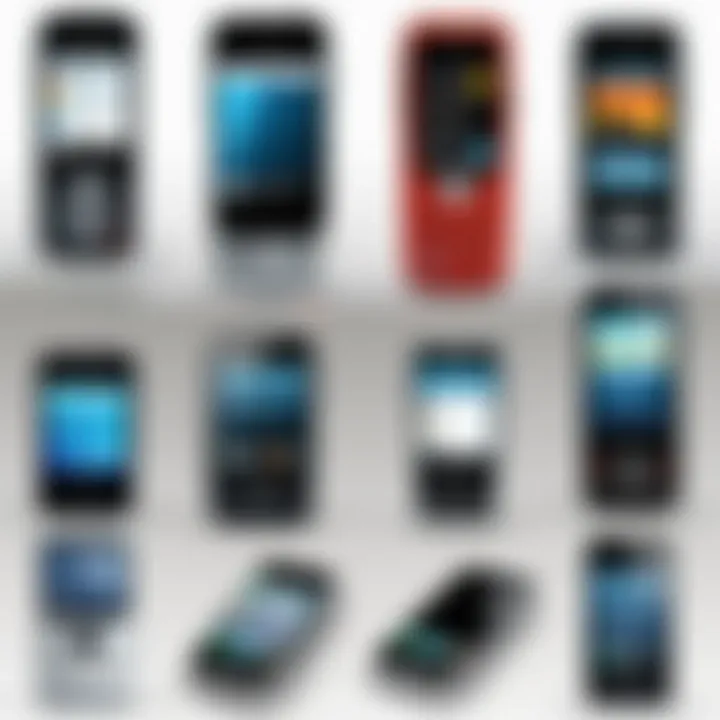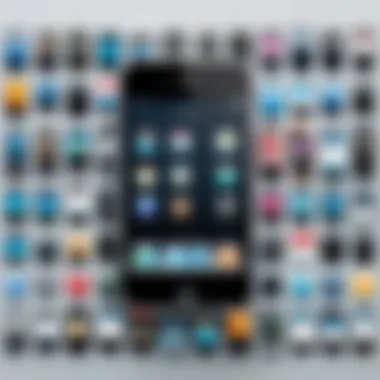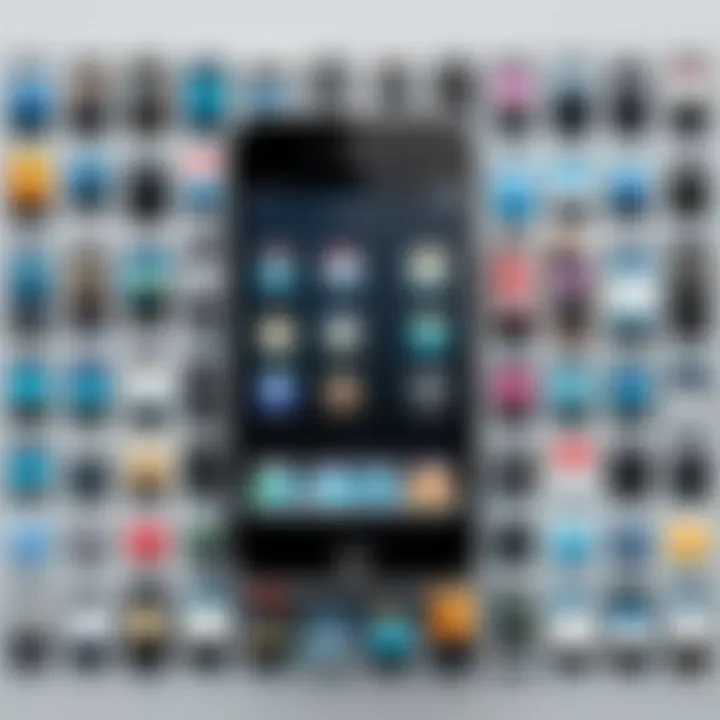The iPhone in 2000: A Foundation for Mobile Innovation


Intro
As the dawn of the new millennium approached, the mobile technology landscape was in a state of flux. Handheld devices were yet to embrace the full spectrum of features consumers would soon take for granted. In a world already buzzing with communication and connectivity, the stage was being set for something transformative. It was in this context, during the year two thousand, that the seeds for the iPhone were planted, a device that would later revolutionize the very fabric of mobile interaction.
The year 2000 was a time when mobile phones were often characterized by their practicality rather than their sophistication. Basic functionalities ruled the day, and the idea of accessing the internet, let alone running applications, was still relatively foreign to many. However, there were whispers of change. The introduction of smartphones—though rudimentary compared to later models—marked a shift in consumer expectation. As various technologies converged, an undeniable wave of innovation began to take shape.
In hindsight, we can appreciate how this moment was not just about technology but also about vision. Steve Jobs, a name synonymous with groundbreaking change, played a pivotal role in this narrative. His understanding of technology went beyond mere hardware; he foresaw a world where devices could integrate seamlessly into users' lives, dissolving the barriers between functionality and pleasure. The conduits for this vision were being laid, and mobile technology was at the forefront.
The evolution of the user interface during this time cannot be overlooked. The clunky designs of past decades were gradually being replaced by more intuitive systems, setting the groundwork for the sleek experience that would characterize the iPhone. As various companies toyed with touchscreen technology, it was clear that the future of mobile interaction was evolving rapidly.
Therefore, in examining the early roots of the iPhone, we must also consider the broader societal context. The early 2000s saw a distinction between mere gadgets and what technology could become—a pivotal realization. With consumer demand evolving, the industry took note of this shift, anticipating features that would soon become common. This article aims to uncover the foundational elements of this discourse, weaving together the technological, social, and visionary threads that would eventually lead to the creation of a cornerstone in mobile innovation.
Prelims
The year 2000 marked a significant juncture in the trajectory of mobile technology, as it set the stage for what would eventually become a sweeping revolution in personal communication. This article seeks to unravel the threads that contributed to the birth of a device that is now an inextricable part of modern life – the iPhone. Understanding the context of the early 2000s involves considering the interplay of various technological advancements, market dynamics, and individual visions that shaped not only Apple but the broader landscape of mobile technology.
As we delve deeper into the importance of this era, it’s essential to highlight a few critical elements:
- Technological Convergence: In the early 2000s, mobile phones were beginning to see a shift from simple communication tools to more multifaceted devices. This period was pivotal for the integration of functionalities that would later characterize smartphones.
- Consumer Expectations: The tech-savvy consumer base was becoming increasingly discerning, demanding devices that were not only functional but also intuitive and aesthetically pleasing.
- Innovation and Vision: The role of visionary leaders, particularly Steve Jobs, became paramount in driving the industry toward a new horizon. His approach to melding design, technology, and user experience opened the door to possibilities that few had imagined.
Considering these elements, the following sections will explore various factors in depth, painting a comprehensive picture of how the iPhone came to be. This includes a look at earlier mobile devices, key players in the smartphone market, and the cultural attitudes that influenced technological adoption. By examining these dynamics, we will see that the iPhone didn’t emerge in a vacuum; it was birthed from a confluence of innovations that laid the groundwork for its groundbreaking entry into the world.
"Innovation distinguishes between a leader and a follower."
– Steve Jobs
By reflecting on the interplay of innovations leading to the iPhone, we can appreciate how a solitary device went on to reshape the digital landscape.
The Rise of Mobile Technology
The turn of the millennium marked a significant shift in how society interacted with devices. As daunting as it sounds, the rise of mobile technology set the stage for a world that would soon become intimately tied to handheld gadgets. In the context of this article, understanding this rise is essential, as it outlines the timeline leading up to the groundbreaking launch of the iPhone.
Mobile technology was more than just a convenience; it was a revolution that transformed personal and professional interactions. The period saw advances in telecommunications, making way for devices that could fit snugly in one's pocket yet carry a world of possibilities. The significance of this rise can be examined through specific elements such as the emergence of smartphones before the iPhone and the key players who carved their niches in this expanding market.
Smartphones Prior to the iPhone
Before the iPhone left its indelible mark, numerous devices managed to sow the seeds of what smartphones could become. Arguably, one of the earliest challengers in this space was the BlackBerry. Renowned for its physical keyboard and secure email functionality, it catered primarily to business professionals. However, BlackBerry’s focus on corporate communication didn’t precisely align with the evolving landscape of a more consumer-oriented technology. Furthermore, devices like the Palm Treo introduced touchscreens and a more user-friendly interface that hinted at the future of mobile technology, albeit lacking the seamless integration we associate with Apple products today.
- Palm Treo offered early adopters a glimpse into an interconnected world.
- Nokia's Symbian OS was a serious contender, evolving and adapting in its early iterations.
- The rise of wireless communication gave way to possibilities that had previously been confined to desktop setups.
By the time the iPhone hit the market, smartphones were already becoming prevalent, yet they were often clunky with their keyboards and limited app ecosystems, resulting in a user experience that varied widely.
Key Players in the Mobile Market
At the helm of the burgeoning mobile market were a few key players who would eventually compete for dominance. The likes of Nokia, Motorola, and BlackBerry were entrenched in the fabric of mobile communication. They laid the groundwork for the expectation of a mobile device as not just a phone but a multifaceted tool.
Nokia
Nokia, in particular, was synonymous with mobile phones during the late 90s and early 2000s. With its durable and reliable hardware, its phones were ubiquitous in both urban and rural settings. However, as the demand for more advanced technology grew, Nokia struggled to adapt quickly to the times.
Motorola
Motorola’s introduction of the Razr captured significant market attention, showcasing a blend of style and technology, demonstrating that a phone could be a fashion statement in addition to being a communication tool.
BlackBerry
As mentioned earlier, BlackBerry targeted business users with its secure e-mail capabilities. However, the company's reliance on a specific market demographic limited its customer reach, ultimately leaving a gap that an innovative player could exploit.
The vibrancy of competition among these established giants laid the foundation for the innovation that Apple would shortly introduce with the iPhone. It's crucial to recognize that before the iPhone’s debut, the landscape was ripe for disruption—something a visionary leader like Steve Jobs capitalized on skillfully.
In summary, the rise of mobile technology illuminated a path that was both exciting and challenging, setting the stage for a device that would reshuffle the deck entirely. As we further explore innovations that led to the iPhone, it becomes clear how interconnected these developments were with societal needs and technological aspirations.


Innovations Leading to the iPhone
The Role of Touchscreen Technology
In the early 2000s, the notion of interacting with devices through a smooth, glass surface was on the cusp of a breakthrough. Touchscreen technology was pivotal to the evolution that led to the iPhone. Before this innovation gained traction, mobile phones often relied on small buttons and physical keypads. These methods not only limited the user experience but also made it cumbersome to execute multiple tasks efficiently.
The touchscreen's initial prototypes and early implementations, especially resistive and capacitive systems, showcased the potential for a more fluid interaction. For instance, companies like Palm introduced devices that used styluses for navigation. While this was a step forward, it wasn't until the emergence of capacitive touchscreens—which could detect multiple points of contact—that the full potential of intuitive gestures, such as pinch-to-zoom and swipe, became evident.
With the anticipated launch of the iPhone, developers scrambled to refine this technology. By the time Apple entered the market, touchscreens had shifted from mere novelties to essential features that defined the user experience. This transition not only altered the landscape of mobile devices but also influenced other tech sectors, and it paved the way for future innovations. Touchscreens empowered users in ways unimaginable, transforming how people interacted with technology in everyday life.
"Touchscreen technology did not just offer a better viewing experience; it changed how we engage with our devices—nurturing an environment for new apps and functionalities that catered to diverse needs."
Advancements in Wireless Communication
Wireless communication was another cornerstone innovation that laid the groundwork for the iPhone. In the year 2000, mobile technology experienced rapid metamorphosis, largely due to improvements in cellular networks. The shift from 2G to 3G networks enabled the transmission of data far quicker and with more reliability than ever before. This technological leap opened the floodgates for services that required stable and fast connections—streaming music, video chats, and eventually, social media.
Consider the role of GPRS (General Packet Radio Service) and EDGE (Enhanced Data rates for GSM Evolution). These advancements made it feasible for devices to access the internet seamlessly. By giving users the ability to browse websites, send emails, and engage with content on the go, mobile devices evolved from mere communication tools to versatile platforms. With these capabilities, the groundwork was being laid for the smartphone revolution.
Moreover, the impending release of other wireless communication standards, such as Wi-Fi, added another layer of connectivity. Suddenly, users weren’t just limited to cellular networks; they could connect to the internet through various means, enhancing productivity and access to information.
The iPhone aimed to encapsulate all these advancements—merging them into a single device that could serve multiple roles in both professional and personal arenas. Thus, wireless communication wasn’t merely an addition to the iPhone’s features; it was intrinsic to the very idea of what a smartphone could be.
The Vision of Steve Jobs
Steve Jobs was not just the face of Apple; he was a harbinger of change in the tech sector. His vision encompassed a future where technology would not only be usable but also an extension of oneself. In the year 2000, while the smartphone market was carving its niche, Jobs was already laying the seeds for a shift that would redefine not just Apple but the entire mobile landscape.
Leadership and Innovation
Jobs’s leadership style was unique and often controversial. He was known for his relentless perfectionism, which pushed his teams to their limits. This drive for excellence resulted in innovative products that often defied conventional market wisdom. Take, for example, his insistence on developing a mobile device that prioritized user experience above all else. He understood that consumers didn't just want a product; they craved an experience that was both intuitive and delightful.
This innovative mindset reflected in Apple's development practices, where iterative design and rapid prototyping became the cornerstones of product development. Jobs encouraged a culture where failure was not just accepted, but celebrated as a stepping stone to success. He famously said, "Innovation distinguishes between a leader and a follower." This mantra cultivated an environment ripe for creativity and breakthrough ideas.
Design Philosophy
Jobs's design philosophy was rooted in simplicity and elegance. He believed that technology should be accessible to everyone, not just tech enthusiasts. His penchant for minimalist design can be seen as a reaction against the typically clunky products of that time. He wanted gadgets that would seamlessly integrate into users' lives, rather than complicate them.
The iPhone, when it eventually launched, was the epitome of this design ethos. It had a clean interface, with a focus on touch navigation, moving away from the stylus-based systems that prevailed before. The large screen allowed for rich multimedia experiences, making the device not just a phone, but a portable multimedia center.
In Jobs’s eyes, form was just as crucial as function. Every angle, texture, and color was meticulously considered. This is what set Apple's design apart in a sea of competitors, establishing a legacy that still echoes in today's tech products.
Jobs's approach to design highlighted several principles:
- Minimalism: Less is more, a principle that could be observed in both hardware and software.
- User-Centric Focus: A deliberate shift towards understanding and anticipating user needs.
- Holistic Integration: A seamless relationship between hardware and software, which meant that products were designed as cohesive units rather than disparate parts.
To conclude, Jobs embodied a vision of technology that went beyond mere functionality; it was about creating an emotional connection with users. His foresight and leadership set the wheels in motion for a mobile revolution that remains influential decades later.
The Integration of Software and Hardware
The successful integration of software and hardware in mobile devices like the iPhone marks a critical milestone in the evolution of technology. When we think of the year 2000, we remember a time when mobile devices began to pivot from simple communication tools to more complex platforms. This transition highlighted the significance of creating a harmonious relationship between the operating systems that power these devices and the hardware that supports them.
In a nutshell, it’s about how well these two elements work together. The smoother the synergy, the better the user experience. This integration opened doors for new functionalities and experiences that users hardly imagined before. As a result, developers could create applications that truly utilized the inherent capabilities of a mobile device rather than just adapting existing software without considering hardware limitations.
The advantages of this synergistic relationship cannot be overstated. To illustrate:
- Enhanced Performance: With tailored software, devices could process tasks more efficiently, leading to faster loading times and reduced lag.
- Optimized Battery Life: Smart software configurations ensured that hardware components operated at their best without draining power unnecessarily.
- Expanded Features: New functionalities emerged, as the effective collaboration between hardware and software allowed for integrations like GPS, high-resolution cameras, and various sensors in a single device.
That said, creating this perfect blend comes with its own set of challenges. Developers had to navigate the intricacies of hardware specifications while crafting software that was both powerful and user-friendly. A device might be equipped with state-of-the-art hardware, but if the software couldn’t leverage it properly, that power would go untapped.
Software updates also play a vital role in maintaining this integration. Regular updates not only fix bugs but also introduce new features and optimizations that enhance the capability of the device's hardware. This dynamic adjustment ensures that even older hardware can remain relevant with new software developments.


"Great technology is not just about the parts that make it; it is the way those parts come together to create something exceptional."
Operating Systems of the Era
During the year 2000, mobile operating systems were still in their infancy, and various platforms were jockeying for position in the emerging smartphone market. Notably, systems like Palm OS and Windows CE were popular, but they presented an experience that was less than seamless.
Palm OS catered to a niche market that prized simplicity over complexity, while Windows CE attempted to bring desktop experiences to handhelds. But neither truly captured the mass consumer market. Features we now take for granted like intuitive interfaces, multitasking, and user-friendly ecosystems were still largely in development. The groundwork was there, but a cohesive and effective operating system wasn’t fully realized until the iPhone emerged.
The Emergence of User-Centric Design
As the year 2000 set the stage for the future, the attention began to shift toward user-centric design. The early mobile devices were often created with a focus on the technology itself rather than the needs and preferences of users. However, as technology grew more sophisticated, so did users' expectations. They desired devices that were not just functional but also aesthetically pleasing and intuitive to operate.
This shift pushed companies to rethink how they approached design. Instead of prioritizing hardware specs, brands began investigating how users interacted with their products. This led to an emphasis on:
- Intuitive Interfaces: The rise of touchscreen technology paved the way for interfaces that were easy and enjoyable to navigate, making devices more accessible to the general public.
- Aesthetic Appeal: A well-designed product not only performs well but also looks good. This principle drove innovation in design over the next few years.
In summary, the intertwining of software and hardware during this time period set the stage for a new realm of electronic communication. The iPhone, in all its complexity, stood on the shoulders of the year 2000's pioneering efforts, ready to redefine mobile communication forever.
Market Predictions and Speculations
Understanding market predictions and speculations is vital when discussing the evolution of mobile innovation during the year 2000. As the technological landscape was rapidly changing, many were beginning to anticipate how devices would integrate into daily life. This was not merely about gadgets, but about the potential shifts in consumer behavior, the emergence of new business models, and the future of digital interaction. The needle was moving, and foresight in this realm could help give context to the iPhone's eventual arrival.
Consumer Expectations of Mobile Devices
By the start of the new millennium, consumers began to show a growing appetite for devices that offered more than just calling capabilities. They yearned for a product that fused functionality with convenience. Imagine a world where people were not just texting but sending pictures, listening to music, and accessing the internet on the go. This changing expectation was fundamentally reshaped by several key elements:
- Portability: As lifestyles became increasingly mobile, expectations for lightweight and compact devices surged. Consumers imagined phones that could fit comfortably in their pockets yet provide expansive functionality.
- Connectivity: Early adopters were already envisioning a future where seamless internet access was essential. They wanted to browse websites, check emails, and engage on social networks, all while on the run.
- User Experience: The push for intuitive interfaces became increasingly clear. Users desired a seamless experience where technology felt like an extension of themselves rather than a cumbersome tool.
"Consumers began to demand not just mobility from their devices but also an elegant simplicity that made interactions frictionless."
This evolution in consumer expectations wasn’t just a passing trend; it also presented a wealth of opportunities for developers and manufacturers to innovate and meet this mounting demand.
Predictions from Industry Experts
Industry experts in the early 2000s had their eyes on the horizon, each putting forward their own ideas about the future of mobile technology. These predictions were rooted in both analysis and enthusiasm, setting the stage for significant developments to come. A few key insights emerged during this time:
- Integration of Functions: Many analysts agreed that future smartphones would serve multiple purposes, combining features of PDAs, cameras, and music players into singular devices. This multifaceted approach was predicted to be the cornerstone of forthcoming products.
- Rise of Application Ecosystems: Experts speculated about the significance of applications and how they would revolutionize the way users interacted with their devices. The idea of an app store was merely a concept at that point, but many foresaw that third-party engineers would create tools that could customize user experiences.
- Focus on Media Consumption: Another noteworthy prediction was the shift in consumer behavior towards mobile media. Shifting trends indicated that users would increasingly prefer to consume not just texts but also videos and music directly on their devices.
As the landscape continued to change, these bold projections shaped the conversations among tech enthusiasts and influenced the strategic decisions of companies like Apple. Understanding these speculations not only highlights the ingenuity of the era but also lays a foundational backdrop for the groundbreaking launch of the iPhone.
Societal Context and Technological Adoption
Understanding the societal context in which the iPhone emerged is critical, as it highlights how cultural attitudes and societal issues shaped technological adoption. The year 2000 was marked by rapid progress, yet it was also a period of reflection on the roles these emerging technologies played in everyday lives. The iPhone did not just arrive as a device; it was a response to shifting perceptions about communication, connectivity, and the very way humans interact with technology.
Cultural Attitudes Towards Technology
Back in the early 2000s, technology was beginning to permeate daily life, but not without a cultural pushback. People were still figuring out how to mix their daily existence with the growing digitization around them. The smartphone was still a novelty, and conversations often revolved around the balance of convenience versus intrusion. Many viewed the advent of the mobile phone as a double-edged sword.
- Privacy Concerns: As phones could now do more than just make calls, users began to wonder about their privacy. The thought of a device that could track location, store personal information, and connect to the internet, raised alarms about data security. This sentiment still lingers today, though it's often clouded by the convenience these devices bring.
- Integration vs. Isolation: President Bill Clinton's administration had championed internet access as a means of leveling the playing field. This was juxtaposed with fears that technology was causing people to become more isolated. Schisms of thought emerged, questioning whether technology was enhancing human interaction or eroding it.
Addressing these concerns during this time wasn’t straightforward. Companies like Apple recognized the need to navigate this tricky landscape and foster trust with their consumers. As devices like the iPhone approached launch, they would need to convince a wary public that they weren't just selling gadgets, but gateways to a better life.
The Digital Divide
Another critical aspect was the digital divide— the gap between those who could access and utilize digital technologies and those who could not. In the year 2000, nearly 50% of American households had access to the internet. This statistic masks larger disparities, particularly among demographics based on income, education, and geography. Rural areas often lagged in connectivity, while city dwellers began to embrace mobile technology more readily.
The digital divide also raises important considerations for how innovations like the iPhone would be received differently across different segments of society:
- Affordability: The cost of a smartphone was a concern for many. Even if they wanted the latest technology, a significant portion of the population could be left in the dust simply because the price of entry was too high. Apple’s pricing strategy would need to take this into account after the iPhone was introduced.
- Education and Literacy: With advanced technology comes the necessity of a certain level of digital literacy. The digital natives, typically younger users familiar with tech from an early age, were poised to adopt devices swiftly. But older generations or those less familiar had to grapple with broader implications of this shift.


In hindsight, understanding these societal factors is key to grasping how the iPhone became more than just a phone in the years that followed. It was more of a cultural icon bridging various gaps, ultimately influencing how technology integrates into human lives.
The launch of the iPhone in 2007 was predicated on years of cultural transition. Without understanding the context in which it arose, its significance is lost amid the noise of technological advancement.
Features that Shaped the iPhone
The iPhone's significance as a pioneering device doesn't just stem from its sleek design or brand allure. Rather, it lies in the features that transformed how we interact with technology. From its intuitive interface to its multimedia capabilities, each element was a stepping stone in redefining mobile devices and setting high expectations for future innovations in the smartphone realm.
User Interface Elements
When discussing the iPhone, one can't overlook the revolutionary user interface. Prior to its launch, many smartphones were tethered to physical keyboards and clunky navigation systems. The iPhone introduced a completely touch-centric experience, making user interactions more fluid and engaging. A key component was the introduction of a capacitive touchscreen, which allowed for smooth gestures like pinch-to-zoom and swiping.
- Touch Accessibility: The interface made it accessible to a wider audience, bridging generational gaps by employing natural finger movements instead of the often tedious stylus input seen in earlier devices.
- Visual Feedback: The graphical responses to user actions—like icons dancing upon touch or the way an app would jiggle when selected—made for a delightful user experience. It made using a smartphone feel not just functional, but enjoyable.
- App Layout: The grid layout for apps was another clever design choice. It shifted the focus from singular functionalities to a broader ecosystem of applications, ultimately fostering the app culture that permeates today’s mobile landscape. Customization allowed users to arrange apps according to their preference, creating a sense of personal ownership over their devices.
In essence, the user interface elements of the iPhone did not merely serve as a blank canvas; they created an immersive environment that invited users to explore and interact with technology in ways that felt like a natural extension of themselves.
Multimedia Capabilities
The iPhone’s multimedia features were another game changer. At the onset of the 2000s, mobile devices primarily functioned as communication tools. The idea of recording and sharing multimedia content was still in its infancy. However, the iPhone took a bold leap—ushering in a paradigm shift that blurred the lines between telephony and entertainment.
- Camera Integration: The ability to take photos and later, videos, directly on the phone was life-altering. A decent camera practically grew in users' pockets, spawning the rise of social media sharing, as people could instantly upload their captured moments. Quick and easy photo sharing redefined social interactions and turned many users into amateur photographers.
- Music and Video Playback: While the iPod was already a loved device, the iPhone melded the functions of a media player with a phone. Users could now access a world of songs, play videos, and even stream content on-the-go without needing multiple gadgets. This all-in-one functionality catered to the lifestyle of a rapidly evolving mobile consumer base.
- Application Ecosystem: The App Store that followed the iPhone's launch provided a platform for countless multimedia applications. There was suddenly an endless array of games, editing tools, and social apps that amplified the iPhone's multimedia capabilities.
Thus, the features that shaped the iPhone, especially its interface and multimedia capabilities, did more than make it a smartphone; they heralded a new era. The iPhone didn’t just follow trends; it set them. The merging of these capabilities created a rich digital landscape where possibilities became endless.
"The introduction of the iPhone was not just about launching a device; it was about changing lives through technology."
By revolutionizing both user interaction and multimedia accessibility, the iPhone effectively changed the tech conversation—a discussion that continues to evolve to this day.
The End
The exploration of the iPhone's origins in the context of the year two thousand is not merely an examination of a product but a deeper reflection on how various threads of technology, culture, and leadership converged to create a revolution. Understanding this nexus helps to appreciate the layers involved in the iPhone's eventual presence in the market and its far-reaching impact.
Reflecting on the iPhone's Legacy
When one considers the legacy of the iPhone, it becomes clear that its importance extends beyond just being a smartphone. The iPhone initiated a fundamental shift in how we interact with technology and, by extension, each other. By effectively blending multiple functions—like email, music, and calling—into one device, it set a new standard in the industry, reshaping consumer expectations.
Furthermore, the legacy of the iPhone is encapsulated in its user-centric design philosophy, which emphasized simplicity and accessibility. This design approach didn’t just cater to tech enthusiasts but also made technology approachable for average individuals. As a result, it played a crucial role in driving the mass adoption of smartphones worldwide, bridging the gap between tech-savvy users and those who were previously intimidated by gadgets.
"The iPhone was not just a product; it was a lifestyle that permeated daily life in ways we could scarcely predict."
It's also worth noting how the iPhone's launch signaled the start of a technological arms race among competitors. The device prompted companies like Samsung and Google to innovate faster, leading to the avalanche of mobile technology that followed. Thus, the innovation set forth by the iPhone catalyzed entire industries and altered our communication landscape.
In summary, the iPhone's legacy is complex and multifaceted. It has influenced not just mobile technology but has also molded cultural attitudes towards communication, technology usage, and even social engagement. As we reflect on this legacy, we must also understand how the groundwork laid during the year two thousand was instrumental in crafting a device that would become a cornerstone of the technology we rely upon every day.
Further Reading
Understanding the technological and cultural context that led to the iPhone's emergence is crucial for comprehending its lasting impact. Further reading allows readers to expand their grasp on mobile technology, the figures behind its innovations, and the industry dynamics during the early 2000s. Engaging with additional sources can deepen insights and highlight nuances that may not be fully covered in this article.
Books on Mobile Technology
Books provide an in-depth exploration of the evolution of mobile technology, especially pre-iPhone devices. These texts often dissect the mechanics of mobile devices, consumer behavior, and the rapid innovation cycle that propelled mobile computing into the mainstream. Titles worth exploring include:
- "Mobile Communication" by Jan A. G. de Bock: This book delves into the sociological aspects that influence why we choose certain mobile devices over others.
- "The Smart Phone Era: Mobile Tech's Dominance" by Emma Royal: This work traces the transformation from early mobile phones to the advanced smartphones we rely on today, tying back to events of the year 2000.
- "The Mobile Revolution: How Mobile Technologies Helped Shape Our World" by David R. Kelly: A critical review of how mobile technology changed our everyday lives and the economy at large.
These volumes highlight how technological innovations influenced consumer expectations and behaviors, giving valuable perspective on the groundwork that led to the iPhone.
Articles on Steve Jobs and Apple Inc.
When it comes to the mastermind behind the iPhone, no discussion is complete without examining Steve Jobs and Apple Inc.'s journey. Articles focusing on their trajectory reveal how Jobs' vision reshaped the landscape of mobile technology.
- "Steve Jobs: A Legacy of Innovation" published on Britannica: This article outlines Jobs' impact on technology and culture, examining his insistence on design excellence and user experience.
- "How Apple Transformed Communication" featured on Reddit: A curated discussion around Apple's marketing strategies and product launches that led to the smartphone boom.
- "The Genius Behind the iPhone: Steve Jobs' Vision" found on Wikipedia: A detailed overview of Jobs’ philosophy and methodology that guided Apple's innovative processes.
These readings not only shed light on Steve Jobs' thought process but also illustrate how Apple's corporate culture fostered breakthroughs that made the iPhone a reality.
By immersing oneself in these supplementary resources, the reader can gain a multidimensional understanding of the elements that interwove to create the iPhone's structural foundation.







